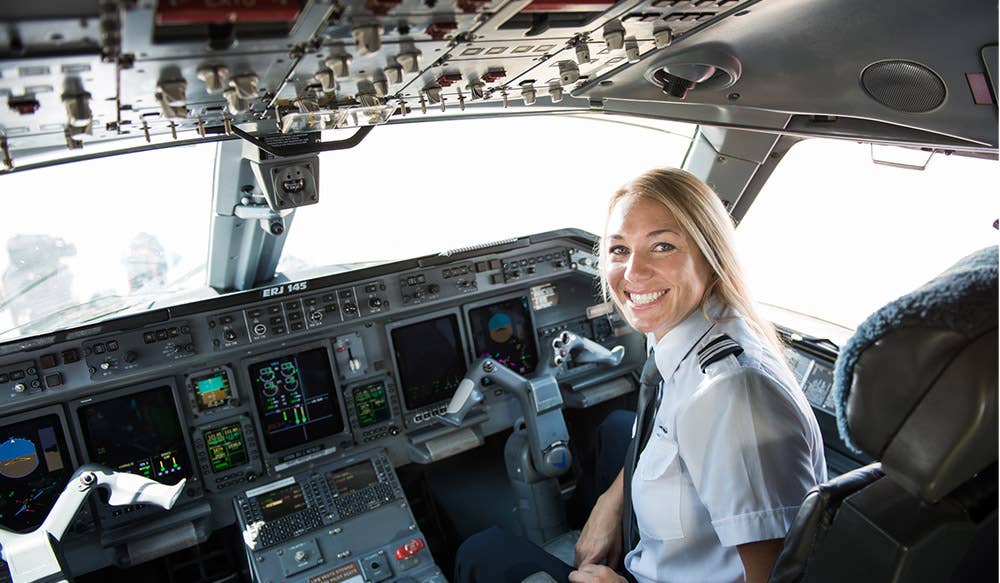
Regional airlines like Envoy Air, an American Airlines subsidiary, are hiring First Officers with appropriate flight training and background qualifications. Envoy Air
Regional air carriers are on a well-documented pilot hiring binge, creating “one of the most exciting times ever” for aspiring airline pilots, says Captain LaMar Haugaard, director of pilot development, and chief pilot at Horizon Air. But recruiters remain selective, weighing candidates’ training backgrounds, flight experience, and even non-pilot qualifications, Haugaard says. Trainees should keep these hiring preferences in mind as they build hours toward the qualifications they need to fly for the airlines.
Flight Experience: Regional airlines typically require pilot applicants to have their commercial, instrument and multi-engine ratings, and be at least within striking distance of obtaining their airline transport pilot certificate from a flight training program. The ATP certificate, mandated by the FAA in 2013 to fly for Part 121 air carriers, represents the biggest change in what regionals want most — or require — in candidates for pilot positions, says Haugaard. An ATP certificate requires 1,500 hours of flight time (or somewhat less for a restricted ATP license). Holders must also be at least 23 years of age. Regionals often hire high-quality, young applicants, and pay for the type rating training, which counts toward their 1,500 needed hours.
Regional airlines also prefer applicants who’ve worked as certified flight instructors (CFIs), especially in instrument (CFII) and multi-engine instrument (MEI) training roles.
“CFIs working in structured programs outperform peers significantly” once hired by regionals, Haugaard says. “Instrument procedures are the foundation of how we operate. We don’t have time to train pilots in these skills — we’re assuming you bring that with you,” he explains. “If you’re teaching instrument procedures on a daily basis, you’re very familiar with these skills and techniques.”
Haugaard notes the Journal of Aviation Technology of Engineering’s Pilot Source Study 2015 found CFIs had fewer non-completions of training at regional airlines than expected, while pilots without CFIs had more non-completions and required more extra training than expected.
Part 135 cargo operations are also a plus, Haugaard says. “If you’re flying in the Rocky Mountains or North Carolina, and the weather’s at 200 and a half [200-foot ceilings and half-mile visibility], I’ll leave my Cessna in the hangar,” Haugaard continued. “But if you’re flying cargo in a Navajo Chieftain, you’re going to go, and learn a lot in the heavy instrument conditions.” In contrast, “banner towing and sky dive operations are almost worthless,” Haugaard says. “You’re not necessarily gaining experience, you’re just repeating more of what you know.”
Training Protocol: Recruiters view programs that train pilots in a standardized crew environment, as superior to ad hoc accumulation of required ratings. Crew-style training is a critical element of these programs, as they familiarize students with the standardized procedures commercial carriers rely on.
“In the airlines, we live and breathe standardization,” Haugaard says. “You get in an airplane with a First Officer you’ve never met, and you know what they’re going to say, and they know what you’re going to say,” as crews work through the checklist and other operational procedures. “It’s very structured.”
Moreover, these immersive programs make students comfortable with the fast-paced learning and execution airlines expect of their pilots during training and beyond. Among the problems regionals face in meeting their hiring needs are the washout rates, or “non completions” of training by pilots they evaluate, and the extra training some candidates are found to need. Pilots trained under crew-style protocols are less likely to wash out or need additional training. This helps explain an interesting finding of the Pilot Source Study: Regional airline applicants with 1,500 hours or fewer, like recent grads of such programs, had fewer non-completions and extra training events, and required less recurrent training than expected, while pilots with more than 4,500 hours had more non-completions than expected.
Education Requirements: College degrees are "preferred but not required" at regionals, Haugaard says. Major airlines all formerly mandated a bachelor's degree for their pilots, but have begun to relax the rule "because of supply issues." However, "it does not matter what the degree is in," says Natalie Nielsen, a pilot and director of pilot recruitment at Envoy Air, simply that the candidate completed a four-year college program.
Extracurricular activities: Expect recruiters to look over social media profiles and postings. Trainees and applicants should also be aware of airlines' grooming policies. "We do not allow visible tattoos, and hair should be off the ears and collar," Haugaard says. "You cannot have full facial hair, unlike our European friends — we want a tight seal on the quick-donning oxygen mask."
Regionals also expect candidates to have the right attitude and work ethic, which is becoming an issue as the current generation enters the workforce. “Millennials have some great things to offer,” says Haugaard. “They also bring an expectation of almost instant success, and we’re all dealing with that to a certain extent.” As a result, airlines are “adapting” polices, for example creating more flexible benefits packages, he says, but applicants themselves need to demonstrate “some level of adaptation and acceptance” of workplace realities.
Finally, recruiters and airlines are interested in more than a pilot’s flying capabilities. “We’re looking for that individual that is part of the community, a holistic individual who has technical skills,” Haugaard says. “Volunteerism, being a good citizen, giving back – those things are important to our corporation.”
Prospects are bright for pilots with these qualifications at the regionals, and for later advancement to a major airline. “The supply issue is very real,” says Haugaard, “and the pool of qualified applicants is indeed getting smaller.”

Sign-up for newsletters & special offers!
Get the latest FLYING stories & special offers delivered directly to your inbox






